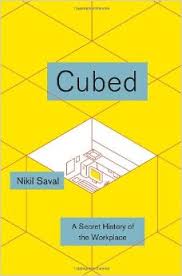Work spaces and Workplaces
 The “office” is a cultural construct made real in three dimensions: a special place for certain kinds of labor. Just as much a work space as a foundry, mine or factory, the labor that takes place in offices is decidedly less physically active and much harder to categorize. I think that elusiveness is one of the reasons Nikil Saval gave his book Cubed an odd subtitle: “A Secret History of the Workplace.” Millions of us toil in offices, cubicles, and work stations. There is nothing secretive about them. The book reveals no secrets. Saval writes about offices how we have end up working in these spaces.
The “office” is a cultural construct made real in three dimensions: a special place for certain kinds of labor. Just as much a work space as a foundry, mine or factory, the labor that takes place in offices is decidedly less physically active and much harder to categorize. I think that elusiveness is one of the reasons Nikil Saval gave his book Cubed an odd subtitle: “A Secret History of the Workplace.” Millions of us toil in offices, cubicles, and work stations. There is nothing secretive about them. The book reveals no secrets. Saval writes about offices how we have end up working in these spaces.
Over the long-term, historians have explained much of this already. Saval leans heavily on focused economic, labor and business histories to document the rise of the clerks and administration. It is a rich body of scholarship that has increasingly taken a sharp eye at power, gender and race. Defining the political and economic tendencies of white-collar workers is an ongoing site of inquiry. However, this is no academic study.
Saval brings architecture, design, anthropology and popular culture to the task. He writes from a journalist’s perspective, illustrating key points with anecdotes and personal stories. Robert Probst, the idiosyncratic designer of the “Action Office” and many other inventions, is featured. So, too, are the architects who designed the seminal office buildings of the twentieth century. Saval travels to the Googleplex and TBWA\Chiat\Day, too, to look at trends in future office design. Large corporations are the norm in Cubed. The home office and the small business are not part of the narrative.
Cubicles, surprisingly, are not front and center. They clearly matter to Saval, who has an underlying political and cultural argument that he struggles to lift out of the larger book. He is concerned about the consequences of the depersonalized anodyne office and its impact on human agency, decision-making and creativity. Others have written about this as well – most famously William Whyte in the Organizational Man. Saval never really wrestles with this is in clear way. Further, he seems to understand technology and its impact on office work. I would have expected him to fold that into his analysis, but instead, it lurks in the background.
Cubed is an interesting book. Saval writes well. He has a good sense of what will pique curiosity about work spaces. Anecdotes and small-bore linkages, though, do not necessarily add up. The whole of the book is less than the sum of its parts. It would have been more successful if Saval had focused more effort on what he thought important and less on what he found interesting.
David Potash